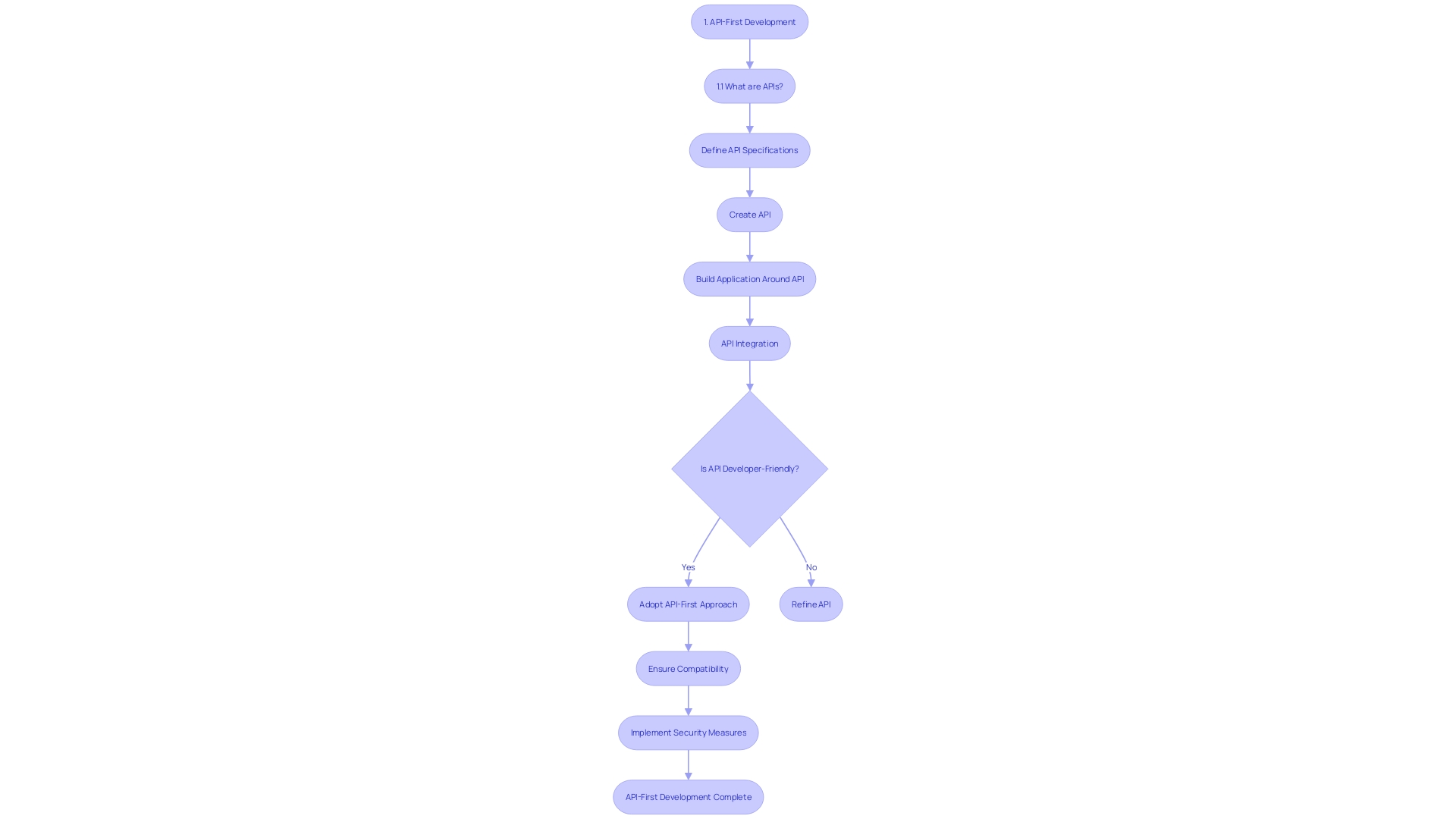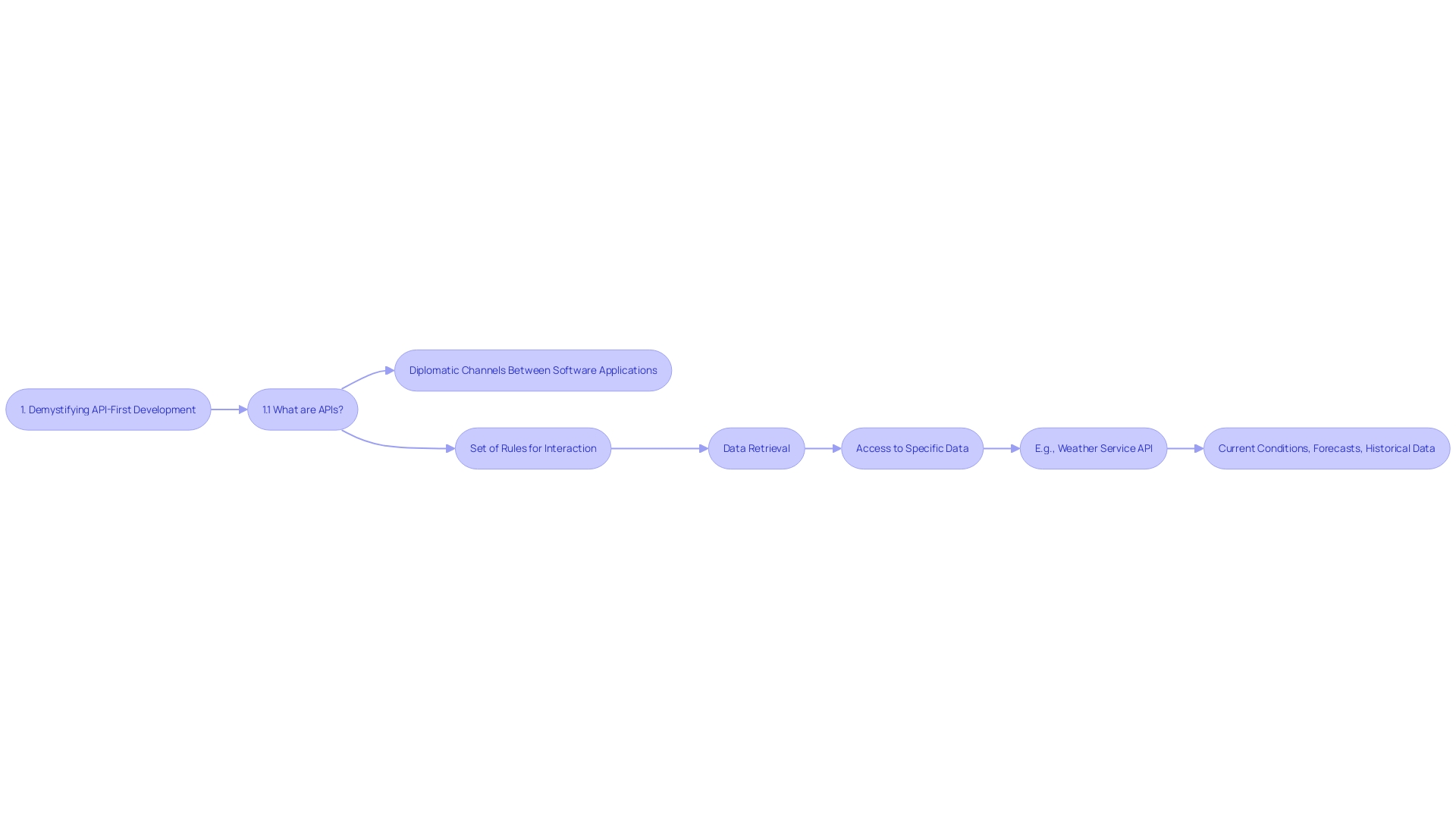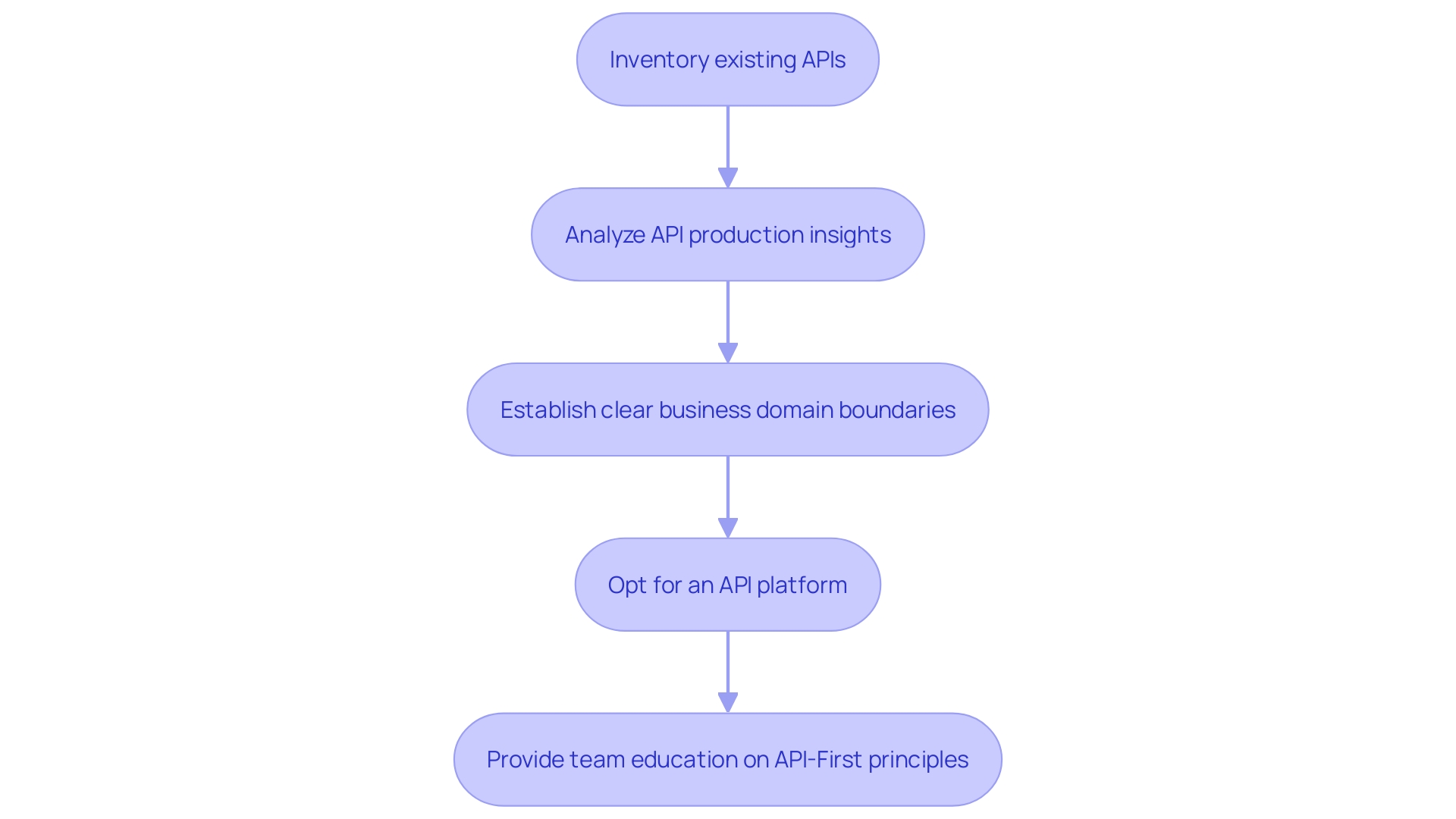Introduction
The API-First approach has revolutionized software development, placing the application programming interface (API) at the forefront. This methodology ensures that APIs are not an afterthought but the foundation of the entire application. By delving deeper into the essence of API-First development, we can uncover its significant advantages.
APIs act as diplomatic channels, vital for communication between different software applications. They govern how software components interact, providing well-defined protocols for activities like data retrieval. The API-First approach prioritizes adoption, developer-friendliness, and compatibility, making APIs accessible and well-designed for a broad range of users and clients.
With the rise of web applications and digital platforms, the importance of API security cannot be overstated. Unauthorized access to APIs can lead to data breaches and cybersecurity incidents, underscoring the need for robust API design from the outset. The API-First model is not just a theoretical concept; it is a real-world strategy that has transformed enterprises, addressing diverse customer needs and maximizing efficiency.
By adopting an API-First approach, developers and organizations can streamline their development processes, foster efficient data retrieval and sharing, and create scalable and flexible software architectures. This article will delve into the benefits of the API-First approach, provide key steps for implementing it, explore real-world examples, discuss challenges and considerations, and highlight best practices for API-First development.
What is API-First?
The API-First approach has transformed the landscape of software development. By placing the application programming interface (API) at the forefront, it ensures that APIs are not an afterthought but the bedrock upon which the entire application is built. This methodology is more than just a trend; it is a paradigm shift that has been increasingly adopted over the past decade.
Let's delve deeper into the essence of API-First development and its significant advantages.
APIs are akin to diplomatic channels, vital for communication between different software applications, each acting as an independent entity. They set the ground rules for how software components interact, with activities such as data retrieval being governed by these well-defined protocols. For example, a weather service API may grant access to real-time weather data, forecasts, and historical weather patterns.
This precise definition and structure of APIs underpin the API-First strategy.
Adoption, developer-friendliness, and compatibility are the cornerstones of the API-First approach. By creating APIs that are accessible and well-designed, a broad range of users and clients can adopt them. This approach ensures ease of integration for developers looking to incorporate your API into their applications or services.
Moreover, it ensures that your application or service can seamlessly integrate with a diverse array of other systems, providing much-needed flexibility and adaptability.
The rise in web applications and digital platforms has escalated the use of APIs. Nonetheless, this surge has also seen an uptick in API breaches, highlighting the critical nature of API security. Unauthorized access to APIs can lead to exposure of sensitive data, underscoring the need for robust API design from the get-go.
Recent reports indicate that a staggering 78% of cybersecurity teams have encountered an API-related security incident in the past year. With only 40% having visibility into which APIs return sensitive data, the prioritization of API security has become more crucial than ever before.
The API-First model is not merely a theoretical concept but a real-world strategy that has been instrumental in the digital transformation of numerous enterprises. It addresses a multiplicity of customer needs, rather than focusing on specific wants. By emphasizing customer needs over wants, the API-First approach ensures that the resulting platforms are versatile and cater to various requirements.

Benefits of the API-First Approach
Adopting an API-First approach unlocks a host of benefits for developers and organizations aiming to streamline their development processes. By prioritizing the creation of APIs at the outset, teams can ensure seamless communication between different software components, akin to establishing diplomatic relations between independent kingdoms. This method not only fosters efficient data retrieval and sharing but also lays the groundwork for scalable, flexible software architectures that can readily adapt to changing business needs.
API-First development champions the idea that APIs are not mere afterthoughts but foundational elements of a robust software strategy. This paradigm shift, as emphasized by industry expert J. Vester, encourages developers to invest their time in delivering value-adding features while utilizing existing frameworks and services for other needs. It's a tactic that aligns with the mission to maximize the utility of one's intellectual property without getting bogged down by already-solved problems.
Case in point, Dunelm Group plc's experience reflects the significance of API-First in supporting organizational and digital platform growth, especially when transitioning to distributed systems for high-revenue-generating frontends. Similarly, lessons from financial institutions underline the importance of focusing on customer 'needs' versus 'wants,' ensuring that APIs are designed with the end-user's requirements at the forefront. This consumer-centric approach ensures that the API provides only the necessary digital resources, thus avoiding the introduction of unnecessary complexities.
Moreover, recent discussions about API-as-a-Service (APIaaS) and its ability to reduce costs and simplify API management underscore the practical advantages of API-First development. The approach is not without potential challenges, as seen in critiques of inflexible data models and manual data ingestion in platforms like Spotify's Backstage. Nonetheless, when executed thoughtfully, API-First development paves the way for broad adoption, developer friendliness, and compatibility across various applications and systems.

Key Steps to Implementing API-First
Adopting an API-First strategy is a transformative process that requires a comprehensive and organized methodology. It's crucial to inventory your existing APIs to gain a clear view of your current landscape. This step should be followed by analyzing API production insights to understand how your APIs are being used and where performance can be enhanced.
Establishing clear business domain boundaries will ensure that your APIs are well-structured and maintainable. Opting for an API platform can facilitate this transition, providing the necessary tools for development, deployment, and management. Lastly, team education is vital; training in API-First principles ensures that your team is aligned with the approach, promoting a consistent and efficient development environment.
For example, consider the philosophy of J. Vester, "Focus your time on delivering features/functionality that extends the value of your intellectual property. Leverage frameworks, products, and services for everything else." This mindset is fundamental in API-First development, where the focus is on creating APIs that enhance your product's core value proposition rather than getting bogged down by solved problems.
To illustrate, Dunelm Group plc's evolution into a high-revenue digital platform necessitated a shift in their software architecture. By adopting a microservice-based backend and innovating on the frontend, they successfully scaled their business. This kind of strategic structural change is at the heart of API-First design, where scalability and efficiency are paramount.
In the context of API-as-a-Service (APIaaS), it's essential to weigh the benefits of efficiency and reduced development time against potential drawbacks like loss of control and security issues. As the technology landscape evolves, solutions like APIaaS offer compelling advantages for companies looking to streamline their API development and management processes.
Understanding RESTful APIs is also a part of the API-First approach. Familiarizing oneself with the principles of REST and the primary HTTP methods—GET, POST, PUT, DELETE—enables teams to create APIs that adhere to industry standards and facilitate smooth integration. The philosophy here is to focus on customer needs rather than wants, ensuring that the APIs built genuinely serve the users and align with business objectives.

API-First in Practice: Real-World Examples
Delving into the practical application of the API-First approach, we can learn from TotalEnergies Digital Factory (TDF), which has been a paragon of digital transformation. TDF, a subsidiary of TotalEnergies, has been pivotal in the company's transition strategy, developing over 80 digital solutions and deploying them across 25 countries. APIs have been instrumental in this process, modernizing legacy systems and facilitating seamless operations.
Another intriguing case is the backend architecture involving multiple microservices at a company where a critical service relied on a third-party API. The event-driven system faced a hiccup when it hit the API rate limit, causing a cascade of operational delays. This incident underscores the importance of robust API management and the potential consequences of overlooking such limits.
Chick-fil-A's Customer Technology team grappled with an API contract issue, where APIs were built without clear, explicit documentation, leading to strenuous cross-team collaborations. This challenge was magnified by the startup-like environment, which initially favored rapid development over formalized API contracts.
These examples highlight the significance of adopting an API-First mindset, where the emphasis on well-designed, accessible APIs leads to widespread adoption, developer-friendliness, and compatibility across systems. As the digital landscape evolves, the role of APIs only grows more central, with recent studies indicating that 60% of organizations suffered at least one API-related breach in the past two years. This underscores the urgency for robust API governance and security practices to safeguard data and ensure operational continuity.
Challenges and Considerations
Navigating the complexities of API-First development can be challenging, even as it offers a multitude of benefits. Overcoming obstacles in this area requires careful consideration of several key factors. Integration with legacy systems, for example, demands a strategic approach to connect new technologies with older infrastructures.
The TotalEnergies Digital Factory (TDF) exemplifies success in this realm, having modernized legacy information systems by making APIs central to their operations. Similarly, effective versioning practices are essential to manage changes and maintain stability across API iterations. Security is another critical concern, as APIs must be safeguarded against unauthorized access and data breaches.
To address this, it is imperative to implement robust authentication and authorization protocols.
Proper documentation stands out as a fundamental aspect of API-First development. The experience of Chick-fil-A's Customer Technology team highlights the importance of clear, well-documented API contracts to facilitate collaboration between teams. The absence of explicit documentation can hinder efficiency, whereas detailed and structured documentation enhances developer productivity and simplifies the integration process.
It's crucial to remember that documentation quality varies widely, and not every company excels at it, as illustrated by Aluisio's experiences with Brazilian banks and ERPs. To mitigate these challenges, developers should focus on creating comprehensive API documentation that includes clear descriptions, structured endpoints, request/response examples, and error handling instructions. This attention to detail in documentation can significantly streamline the developer experience and enhance the overall effectiveness of API integrations.
Best Practices for API-First Development
Embracing API-First development is not just a technical decision but a strategic one that can lead to remarkable efficiency and growth. Illustrated by the transformational journey of Voucherify, which harnessed the power of external APIs to accelerate their delivery speed tenfold, this approach is a game-changer. It's about putting APIs at the forefront, ensuring they are clear, intuitive, and maintainable, which is pivotal for building scalable and robust software.
An API acts as the intermediary, allowing separate software entities to communicate seamlessly. By focusing on consistent naming conventions and comprehensive error handling, we can create an API that's not just a set of functionalities but a reliable and user-friendly tool. Such an API can be easily adopted by developers, enhancing compatibility across different systems.
TotalEnergies Digital Factory's success in deploying over 80 digital solutions across 25 countries with an API-centric model is a testament to the efficacy of this approach. Their commitment to sustainable and accessible energy is propelled by the modernization of legacy systems through APIs, underscoring their operational significance.
Moreover, the importance of community input and collaboration cannot be overstated. The collective knowledge and suggestions from a community of peers drive innovation and improvement in API development practices.
In conclusion, API-First development, by prioritizing the design and creation of APIs, ensures that the foundation laid for software development is solid, adaptable, and primed for success. It's a strategy that not only facilitates technical prowess but also fosters a culture of collaboration and shared progress.

Conclusion
The API-First approach has revolutionized software development by prioritizing well-designed APIs as the foundation of the entire application. It ensures efficient communication between software components and provides clear protocols for activities like data retrieval. This approach prioritizes adoption, developer-friendliness, and compatibility, making APIs accessible and user-friendly.
API security is crucial in the digital landscape, where unauthorized access can lead to data breaches. By adopting an API-First approach, developers and organizations can streamline processes, foster efficient data sharing, and create scalable software architectures.
The benefits of API-First development include maximizing efficiency and productivity by focusing on value-adding features and leveraging existing frameworks. Real-world examples, like Dunelm Group plc and TotalEnergies Digital Factory, highlight the practical advantages of API-First development in supporting growth and scalability.
Implementing an API-First strategy involves key steps like inventorying existing APIs, analyzing production insights, establishing clear boundaries, and investing in team education. Familiarity with RESTful APIs and industry standards, along with comprehensive documentation, are essential for success.
While API-First development offers benefits, it also presents challenges such as integrating with legacy systems, effective versioning, security measures, and proper documentation.
Embracing API-First development as a strategic decision can lead to remarkable efficiency and growth. By prioritizing clear, intuitive, and maintainable APIs, developers can build scalable and robust software architectures. Collaboration and community input drive innovation and improvement.
In conclusion, the API-First approach is transformative, prioritizing well-designed APIs to streamline processes, enhance compatibility, and achieve maximum efficiency. By adopting this approach, developers and organizations can create software that is adaptable, user-friendly, and primed for success in the digital landscape.
Frequently Asked Questions
What is API-First?
API-First is a methodology in software development where the application programming interface (API) is prioritized and treated as the primary building block of the entire application. It emphasizes the design and creation of APIs before anything else in the development process.
Why is API-First considered a paradigm shift?
API-First is considered a paradigm shift because it changes the traditional approach where APIs were an afterthought. Instead, it places APIs at the core of the software development process, ensuring they are the bedrock upon which applications are built.
What are the core principles of the API-First approach?
The core principles of the API-First approach include adoption, developer-friendliness, and compatibility. APIs are designed to be accessible, well-structured, and easy to integrate with various systems and applications.
What role do APIs serve in software development?
APIs act like diplomatic channels between different software applications, allowing them to communicate and interact with each other. They define the rules for activities such as data retrieval and ensure seamless operation between software components.
How important is API security in the API-First approach?
API security is critical in the API-First approach as APIs can be vulnerable to breaches, leading to sensitive data exposure. Robust API design is crucial to prevent unauthorized access and secure the data being exchanged.
What are some benefits of adopting the API-First approach?
Benefits of the API-First approach include seamless communication between software components, efficient data retrieval and sharing, scalable and flexible software architectures, and the ability to adapt to changing business needs.
Can you give examples of real-world applications of the API-First approach?
Real-world examples include TotalEnergies Digital Factory, which used APIs to modernize legacy systems, and Voucherify, which leveraged external APIs to significantly accelerate their delivery speed.
What are the key steps to implementing API-First?
Key steps include inventorying existing APIs, analyzing API usage and performance, establishing clear business domain boundaries, opting for an API platform for development and management, and educating the team on API-First principles.
What challenges might arise with API-First development, and how are they addressed?
Challenges include integrating with legacy systems, versioning APIs, and ensuring security. These are addressed by strategic planning, implementing robust authentication and authorization protocols, and creating clear, well-documented API contracts.
Why is proper documentation essential in API-First development?
Proper documentation is essential because it facilitates collaboration between teams, enhances developer productivity, and simplifies the integration process. It should include descriptions, structured endpoints, examples, and error handling instructions.
What are some best practices for API-First development?
Best practices include putting APIs at the forefront of development, focusing on clear and intuitive API design, maintaining consistency in naming conventions, comprehensive error handling, and encouraging community input and collaboration.




